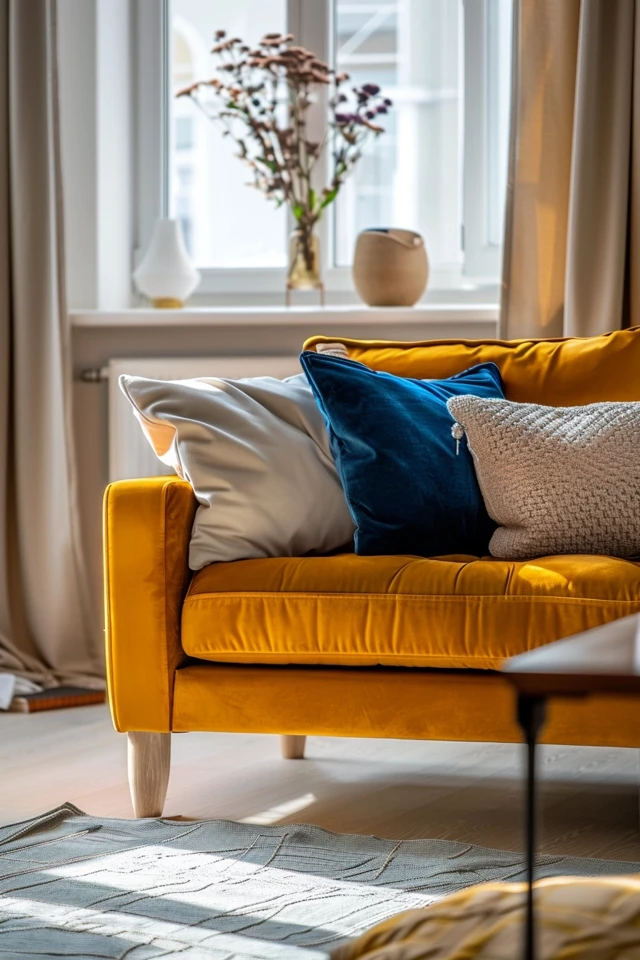Floating furniture in a living room can be a clever tool to create the feeling of more space and improve room flow. Interior designers recommend strategically pulling furniture away from the walls to create zones and a cozy feel. This technique works well in open plan spaces, where it can help to define different areas without the need for physical walls.
Floating furniture also allows for more wall space, making the room look bigger and providing opportunities for storage and decor. Additionally, it can deliver a cozy atmosphere and soften harsh edges. However, this layout may not work in all living rooms, particularly in small or dark spaces.
Key Takeaways:
- Floating furniture in a living room can create the feeling of more space and improve room flow.
- Strategically pulling furniture away from the walls helps to define different areas without physical partitions.
- Floating furniture allows for more wall space, making the room look bigger and providing opportunities for storage and decor.
- This layout may not be suitable for small or dark living rooms.

Benefits of Floating Furniture in a Living Room
Floating furniture in a living room offers several benefits. Firstly, it can help zone an open plan room, allowing for better organization and functionality. By creating designated areas within the space, such as a living room corner or a hidden office corner, floating furniture provides a sense of division without visible partitions. This enables me to create distinct spaces for different activities, such as relaxation, entertainment, and work.
Secondly, floating furniture creates more wall space, making the room look larger and providing opportunities for storage and decor. With furniture positioned away from the walls, I have more freedom to showcase artwork, mirrors, or shelves to add personality and style to the living room. I can even incorporate functional storage solutions like bookcases or wall-mounted cabinets, maximizing both aesthetics and functionality.
Additionally, floating furniture can deliver a cozy feel by creating intimate, conversational spaces and preventing an open-plan room from feeling cavernous. Placing the furniture strategically can help define cozy nooks and establish a sense of intimacy, perfect for gatherings with family and friends. It also helps to soften harsh edges and allows furniture to be admired from all angles, enhancing the visual appeal of the room.

Floating furniture in my living room not only opens up the space but also makes it more inviting and comfortable. I love how it allows me to create distinct areas for different purposes without the need for physical walls. It’s a game-changer for small spaces!” – Jane, interior design enthusiast
While there are many advantages to floating furniture, it’s important to note that this layout may not be suitable for small or dark living rooms or those with unique shapes. Consider the size and natural lighting of the room, as well as any architectural features, before deciding whether to float your furniture. An experienced interior designer can provide guidance and help you make the right choice for your specific space.

Tips for Floating Furniture in a Living Room
When it comes to floating furniture in a living room, there are some important tips to consider. Whether you’re looking for layout tips, living room design ideas, or furniture arrangement tips, these suggestions will help you create a stylish and functional space.
Firstly, for an open plan space, creating a designated living room corner is essential. Position the sofa with its back to the rest of the room to anchor the space and create a cozy atmosphere. To further define the area, add a rug and a coffee table in the center.
Remember, floating furniture is not limited to sofas. You can also use other seating options like daybeds, chaises, or ottomans to create different seating areas in your living room. Consider custom seating with a high wingback chair or modular seating for a unique touch.
When arranging floating furniture, it’s crucial to consider the size of the room and ensure there is enough walking space around each side of the furniture. This will prevent the room from feeling cramped and make it easier to navigate. Additionally, rugs play a crucial role in defining the areas and unifying the space, so choose a rug that complements the overall design.
Lastly, pay attention to small details that can enhance the look of your floating furniture. Consider adding tufting or a fabric panel along the back of the furniture to create visual interest and draw attention to the pieces.

